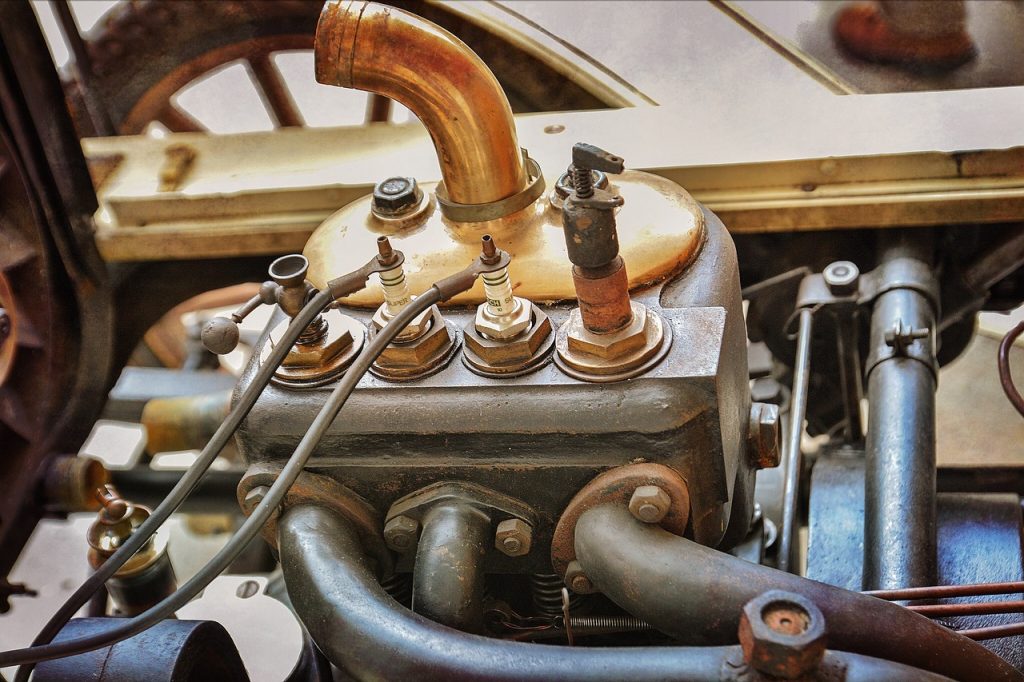Internal combustion engines play a crucial role in our society. They power everything from cars and trucks to generators and lawnmowers. Engines are made up of a complex symphony of components working in unison to transform fuel into motion. Two important parts are the spark plug and the ignition coil.
These two parts are responsible for igniting the fuel-air mixture that propels our vehicles forward and keeps our machines running smoothly.
In this article, we will take a closer look at the intricacies of spark plugs and ignition coils and take a closer look at their individual functions as well as the differences that set them apart.
Spark Plug
Now, let’s dive right into the spark plug.
A spark plug is a small component that plays an important role in the internal combustion engine. Its main job is to ignite the air-fuel mixture within the engine’s cylinders. This ignition is what sets off a controlled explosion and creates the power that drives your vehicle forward.
A typical spark plug comprises several essential components, including an insulator, a central electrode, a ground electrode, and a metal shell. These elements work together to produce the spark that initiates combustion.
When you turn the ignition key or press the start button, the electrical current from the ignition system flows to the spark plug. This current travels through the central electrode and jumps the gap to the ground electrode. This creates a spark capable of igniting the compressed air-fuel mixture in the engine’s cylinder.
The spark plug’s role is critical. A well-functioning spark plug ensures that the ignition process occurs precisely when needed and optimizes engine efficiency and performance. Conversely, a failing or fouled spark plug can lead to misfires, reduced power, and increased emissions.
Ignition Coil
Let’s take a closer look at the second key player in our story: the ignition coil.
While the spark plug plays a central role in the combustion process, the ignition coil plays an equally important supporting role.
What is an ignition coil and why does it matter? The primary function of an ignition coil is to take the low-voltage electrical energy supplied by your vehicle’s battery and transform it into high-voltage electricity. This high-voltage output is what powers the spark plug, generating the spark needed to ignite the air-fuel mixture in the engine’s cylinders.
Let’s break down its construction. It typically consists of two coils of wire—an inner primary coil and an outer secondary coil—wrapped around an iron core. When an electrical current flows through the primary coil, it creates a magnetic field in the iron core. This magnetic field is crucial in generating the high-voltage electricity in the secondary coil.
When you engage your vehicle’s ignition system, the ignition coil begins its work. The low-voltage current flows into the primary coil and creates a magnetic field that collapses when the current is interrupted. This rapid collapse of the magnetic field results in a surge of voltage in the secondary coil. This causes a high-voltage spark. The spark then travels through the spark plug’s electrodes and initiates the combustion process.
Like all components in the engine, the ignition coil’s performance is important for the proper functioning of your vehicle. A malfunctioning or weak ignition coil can lead to irregular or weak sparks. This may cause misfires and reduced engine performance. ensuring your ignition coil is in top shape is important for maintaining the reliability and efficiency of your vehicle.
Key Differences
Now that we’ve looked at both spark plugs and ignition coils, it’s time to look at the distinct differences that set them apart.
Spark Plug vs. Ignition Coil
First and foremost: their primary functions. The spark plug is responsible for creating the spark that ignites the air-fuel mixture within the engine’s cylinders. The spark plug’s job is to initiate the combustion process. The ignition coil serves as the power source for the spark plug. It takes low-voltage electricity from the vehicle’s battery and converts it into the high-voltage spark needed for ignition. While the spark plug delivers the spark, the ignition coil is the spark’s power generator.
Location Matters in Engine Anatomy
Another distinction lies in their physical location within the engine. Spark plugs are located directly inside the engine’s combustion chambers, snugly in the cylinder head. This placement allows them to access the air-fuel mixture and initiate combustion at precisely the right moment. Ignition coils are typically situated outside the combustion chambers, often mounted on the engine’s exterior. They connect to the spark plugs via high-voltage wires, ensuring a reliable flow of electricity to trigger ignition.
Construction and Components
A closer examination of their construction reveals further disparities. Spark plugs feature an insulator, a central electrode, a ground electrode, and a metal shell. These components work together to produce the spark needed for ignition. An ignition coil comprises two coils of wire wrapped around an iron core. This design enables the transformation of low-voltage electrical energy into high-voltage electricity, making it the power source for the spark plug.
Spark plugs rely on electrical conductivity and the generation of a spark across the spark plug’s gap. This spark initiates combustion. Ignition coils operate on electromagnetic induction and leverage the magnetic field created by the primary coil to induce a surge of voltage in the secondary coil. This high-voltage output is what triggers the spark plug’s action.
Despite these differences, spark plugs and ignition coils work hand in hand within the ignition system. The spark plug depends on the ignition coil’s high-voltage output to create the spark, while the ignition coil relies on the spark plug to complete the electrical circuit.
Factors Affecting Performance
It’s important to recognize the various factors that can influence these parts’ performance. Like all vehicle parts, they are not immune to wear and tear.
Factors Impacting Spark Plug Performance:
- Wear and Tear: Over time, spark plugs can degrade due to the high temperatures and pressures they endure during each ignition cycle. This wear and tear can result in reduced spark quality, misfires, and decreased fuel efficiency.
- Heat Range: Spark plugs come in various heat ranges which indicate their ability to dissipate heat. Selecting the correct heat range for your engine is necessary since using the wrong type can lead to overheating or fouling of the spark plug.
- Gap Size: The gap between the central electrode and ground electrode on a spark plug is critical. An incorrect gap size can affect the spark’s strength and timing, leading to performance issues.
Factors Influencing Ignition Coil Performance
- Voltage Supply: Ignition coils rely on a stable and consistent supply of low-voltage electricity from the vehicle’s battery. Any disruptions or fluctuations in voltage can impact the coil’s ability to generate the high-voltage spark required for ignition.
- Coil Design: The design and quality of the ignition coil can significantly affect its performance. Coils with advanced designs and materials may offer improved efficiency and durability.
- Resistance: The electrical resistance in the coil’s windings can impact its performance. Too much resistance can lead to reduced voltage output, while too little resistance can overload the coil, causing overheating and damage.
To ensure that both spark plugs and ignition coils continue to function optimally, your car needs regular maintenance. This includes periodic inspections, cleaning, and, when necessary, replacement.
Common Problems and Troubleshooting
Spark plugs and ignition coils are not immune to issues that can disrupt your engine’s performance. Let’s look at some of the common problems that can arise with these components as well as how to troubleshoot and address these issues effectively.
Common Spark Plug Problems
Fouling: One of the most prevalent spark plug issues is fouling which occurs when carbon deposits or unburned fuel accumulate on the spark plug’s electrodes. This can lead to misfires, reduced power, and poor fuel efficiency.
Troubleshooting: If you suspect fouling, inspect the spark plugs for black, sooty deposits. Cleaning or replacing the fouled spark plugs can restore proper combustion.
Carbon Deposits: Excessive carbon deposits on the spark plug can insulate the electrodes, making it challenging for the spark to jump the gap.
Troubleshooting: Gently clean the spark plugs with a wire brush or specialized cleaner to remove carbon buildup. Ensure the gap between the electrodes is within the manufacturer’s specifications.
Gap Erosion: Over time, the gap between the spark plug’s electrodes can erode, reducing the spark’s intensity and accuracy.
Troubleshooting: Measure the gap between the electrodes using a feeler gauge. If it’s beyond the recommended range, carefully adjust it or replace the spark plug.
Common Ignition Coil Problems
Overheating: Ignition coils can overheat, particularly when subjected to excessive electrical resistance or voltage fluctuations. Overheating can lead to coil failure and intermittent ignition issues.
Troubleshooting: Check for signs of excessive heat, such as discoloration or melting of the coil’s housing. Ensure a stable voltage supply and address any electrical issues promptly. Consider upgrading to a high-quality ignition coil if overheating is a recurring problem.
Coil Failure: Ignition coils can fail due to factors like age, manufacturing defects, or electrical issues. Coil failure results in a loss of spark, causing misfires and poor engine performance.
Troubleshooting: Diagnose coil failure using an ohmmeter or a diagnostic scan tool to measure resistance. If the resistance is significantly outside the manufacturer’s specifications, it’s time to replace the ignition coil.
Wiring Issues: Damaged or corroded wiring connecting the ignition coil to the spark plugs can disrupt the flow of high-voltage electricity.
Troubleshooting: Inspect the ignition coil wiring for signs of damage or corrosion. Replace damaged wires and ensure secure connections to maintain proper electrical conductivity.
Maintenance and Replacement
To ensure the reliability and longevity of your vehicle’s spark plugs and ignition coils, routine maintenance and, replacement when necessary are needed.
Spark Plug Maintenance
- Regular Inspection: Periodically inspect your spark plugs to check for signs of wear or damage. Visual inspection can provide you with information about their condition.
- Cleaning: If you notice carbon deposits or fouling on the spark plugs, you can try cleaning them. Use a specialized spark plug cleaner or a wire brush to gently remove deposits. Make sure to exercise caution not to damage the electrodes.
- Regapping: Measure the gap between the central and ground electrodes using a feeler gauge. If the gap is outside the manufacturer’s specifications, carefully adjust it to the recommended setting. Refer to your vehicle’s manual for the correct gap size.
Ignition Coil Maintenance
- Voltage Supply: Ensure that your vehicle’s electrical system provides a stable and consistent voltage supply to the ignition coil. Address any electrical issues promptly to prevent overheating and coil failure.
- Inspect Wiring: Regularly check the wiring connecting the ignition coil to the spark plugs for damage or corrosion. Replace any damaged wires and ensure secure connections to maintain proper electrical conductivity.
Replacement Guidelines
Despite diligent maintenance, there is a time when replacement becomes necessary due to wear and age. Here’s a when to consider replacing spark plugs and ignition coils:
Spark Plug Replacement:
- Mileage: Spark plugs generally have a recommended mileage interval for replacement, often ranging from 30,000 to 100,000 miles, depending on the type.
- Visual Inspection: If you notice significant wear, fouling, or damage during inspections, it’s time to replace the spark plugs.
- Engine Performance: If you experience misfires, poor fuel efficiency, or a noticeable drop in engine performance, consider replacing the spark plugs.
Ignition Coil Replacement
- Age: Ignition coils can wear out over time, especially if they are original equipment. Consider replacing them as part of your vehicle’s regular maintenance routine, usually every 100,000 miles or as recommended by the manufacturer.
- Overheating: If you’ve identified overheating issues with the ignition coil, it’s essential to replace it promptly to prevent further damage and engine misfires.
- Coil Failure: Diagnostic tests that reveal significant resistance or coil failure should prompt immediate replacement.


